Key takeaways:
- Game environments enhance player immersion and emotional connection through design elements like textures, lighting, and sound.
- Engaging environments foster exploration and curiosity, transforming games into memorable experiences.
- Essential programming concepts, such as collision detection and NPC scripting, significantly contribute to the realism and vibrancy of game worlds.
- Successful game environments, like those in “Alto’s Adventure” and “The Legend of Zelda: Breath of the Wild,” demonstrate the power of visual storytelling and exploration in gaming.
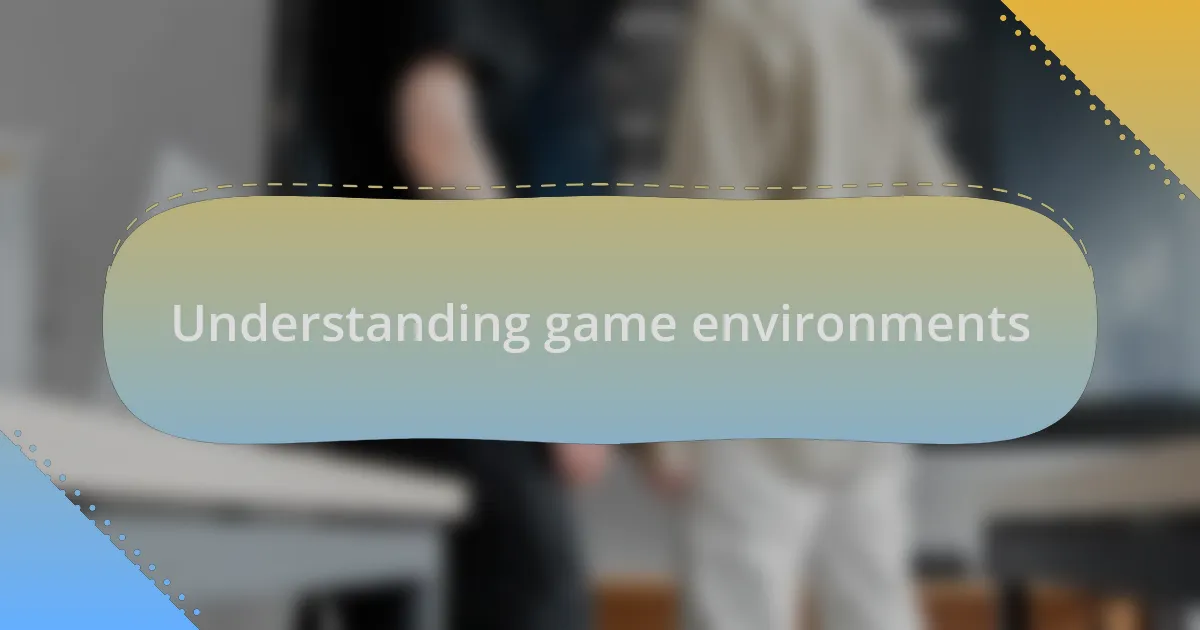
Understanding game environments
Game environments are the heart of a player’s experience, often setting the stage for immersion and interaction. I remember the first time I plunged into an open-world game; the detailed landscape made me feel as if I were truly walking through that virtual realm. It raises the question: how do we create spaces that invite exploration and connection?
Every element in a game environment, from textures to lighting, contributes to the overall atmosphere. I often find myself analyzing what makes a space memorable. Is it the haunting echoes of a forgotten castle or the vibrant life of a bustling town? It’s fascinating how these environments can evoke emotions, making players feel nostalgia or excitement simply through design.
I’ve realized that understanding game environments involves not just technical skills but also empathy for the player’s journey. When building these spaces, considerations of player behavior and emotional response are vital. I think, how can we guide players through narratives visually and fundamentally? Each decision shapes their experience and engagement, turning a simple game into an unforgettable adventure.
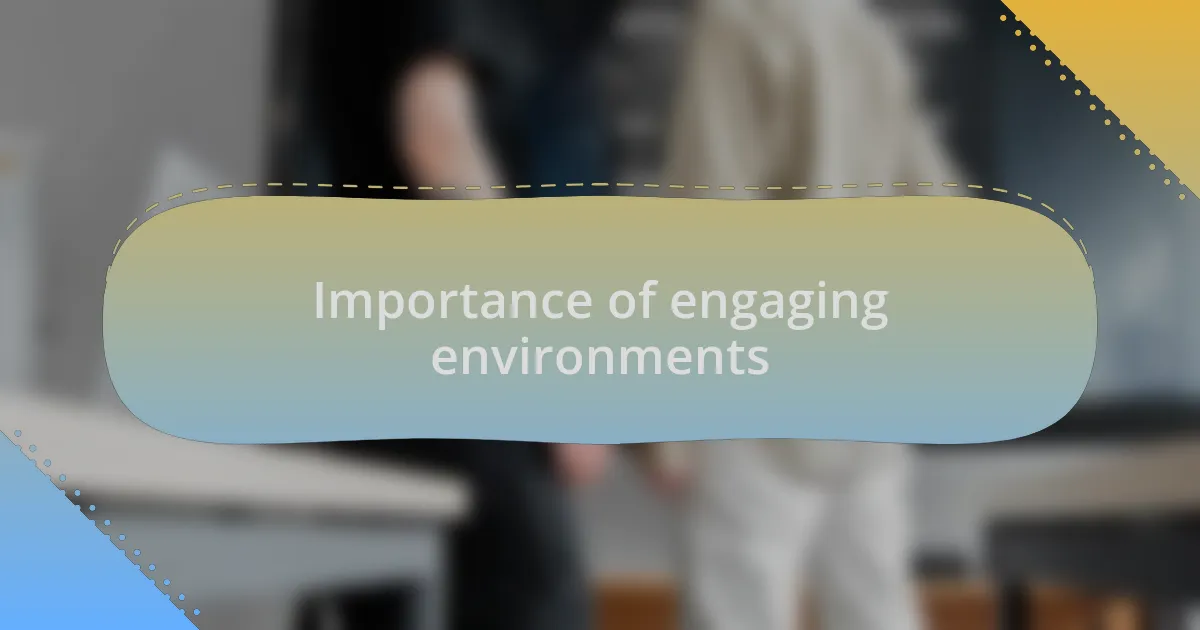
Importance of engaging environments
Engaging environments play a crucial role in capturing a player’s attention and fostering a lasting connection to the game. I remember playing a particularly dark and atmospheric game where the muted color palette made my heart race, amplifying the suspense with every step I took. It’s interesting how the design elements of an environment can influence emotions, making players feel a certain way without them even realizing it.
Moreover, the importance of these environments extends beyond aesthetics; they serve as the backdrop for storytelling. One time, while exploring a deserted village in a survival game, I felt a profound sense of isolation that echoed the character’s struggle. I think, how can we create environments that not only support the narrative but also enhance the overall gaming experience? Keeping players on the edge of their seats, engaged in both story and space, is a delicate balance that can transform a game into an immersive experience.
What I’ve learned is that an engaging environment inspires curiosity and interaction, encouraging players to delve deeper. I often find myself wandering off the beaten path, driven by the environment’s allure, eager to uncover hidden secrets or lore. Isn’t it fascinating how a well-crafted space can lead to moments of discovery that resonate personally? This connection is what elevates a game from being simply enjoyable to truly memorable.
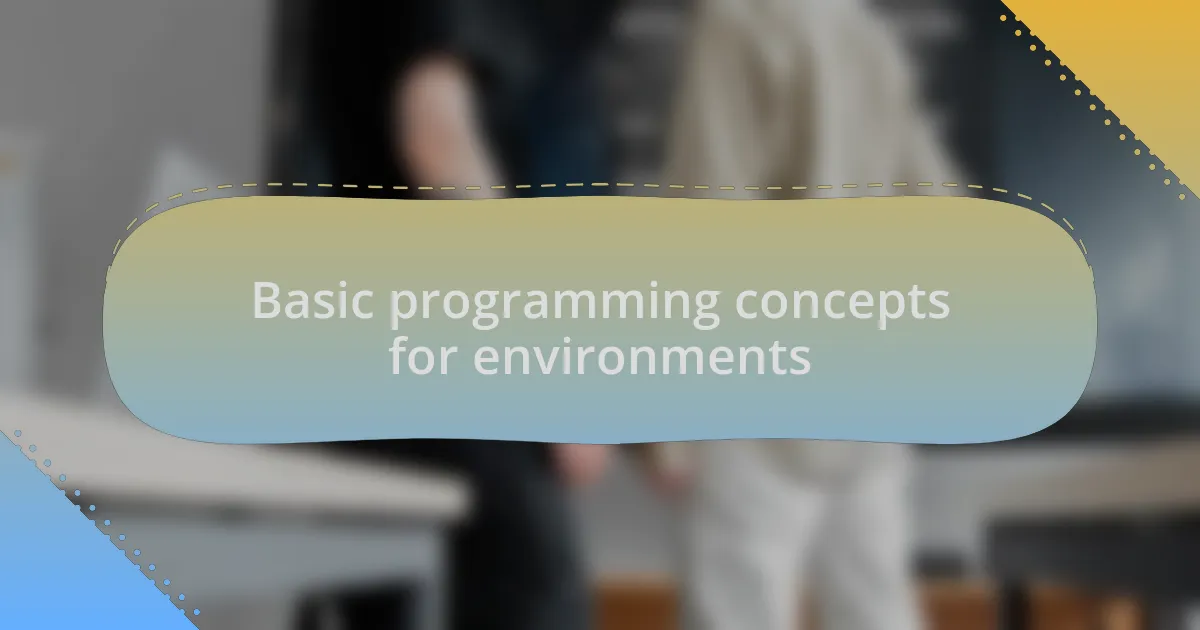
Basic programming concepts for environments
When it comes to programming gaming environments, one foundational concept is understanding graphics and rendering techniques. I recall the thrill of learning about 2D versus 3D graphics; each offers unique advantages and challenges. For instance, while 2D graphics can evoke a sense of nostalgia, mastering 3D rendering can create stunning visuals that immerse players in a richly detailed world.
Another essential aspect involves collision detection, which determines how objects interact within the game space. I remember the moment I finally grasped how to implement collision detection in my first project. The joy of watching my character bounce off walls instead of walking through them was a breakthrough! It’s interesting to think about how these technical elements not only impact gameplay but also enhance the player’s feel of realism. Have you ever noticed how frustrating it is when a character phases through an object? That’s a direct result of collision mechanics at play.
Lastly, scripting behaviors is a critical element for making environments feel alive. I once spent hours programming NPCs with unique routines, and the satisfaction of seeing them interact organically was unparalleled. It struck me how even small details, like an NPC waving hello or reacting to a player’s presence, can breathe life into a game. Isn’t it remarkable how the interplay of code can create such vibrant, dynamic experiences?
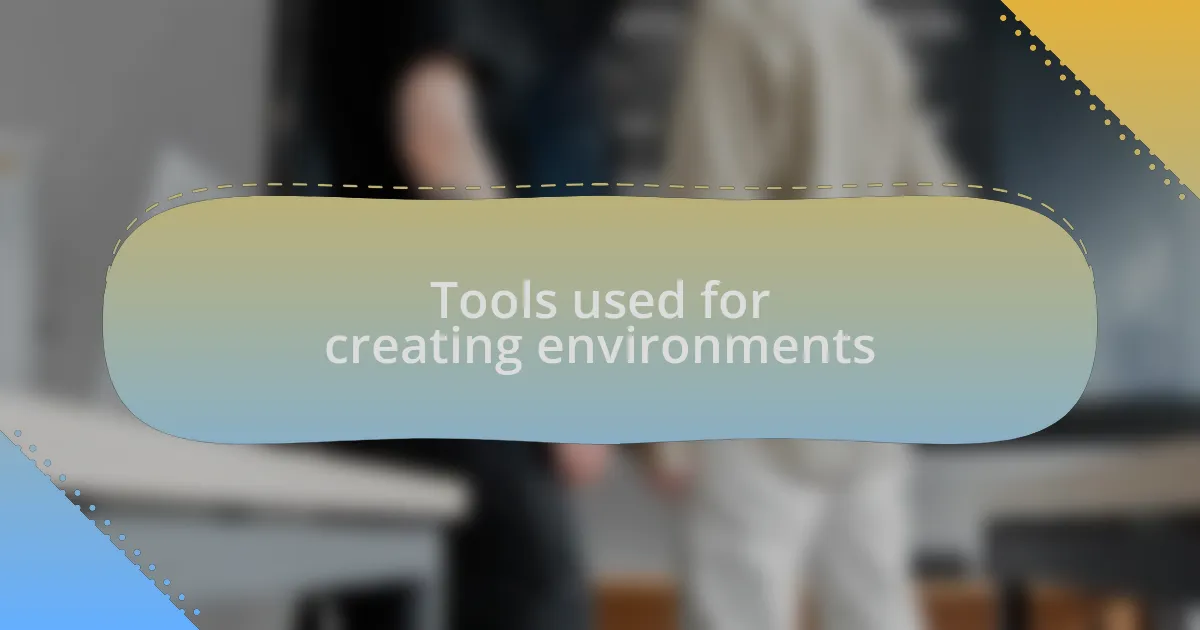
Tools used for creating environments
When it comes to creating engaging game environments, the right tools can make all the difference. For instance, I have found Unreal Engine to be an exceptional platform for building immersive worlds. Its powerful rendering capabilities and Blueprint visual scripting let me whip up intricate designs without having to get lost in lines of code. Have you ever tried crafting a level and felt your creativity just flow? That’s exactly how I felt when I first explored its extensive library of assets.
On the other hand, I can’t underestimate the impact of Unity. With its user-friendly interface and a robust asset store, I’ve created stunning environments while significantly reducing production time. I still remember the first time I put together a lush forest scene—it was tremendously gratifying to see the vibrant colors come to life, all from just a few scripts and assets. For those of you starting out, isn’t it reassuring to know that a tool like Unity can facilitate your excitement for game design?
Moreover, tools like Blender have been game-changers for modeling and animation. I vividly recall spending late nights rigging characters and crafting environmental assets, and how rewarding it was to see my models in action. There’s something so satisfying about taking a 3D model from concept to completion, especially when it adds depth to your game world. What tools have sparked your imagination and helped you bring your ideas to life?

Techniques for enhancing player experience
One technique that I’ve found incredibly effective for enhancing player experience is the incorporation of dynamic lighting. For instance, in one of my projects, I experimented with real-time light changes that responded to the in-game time of day. I saw firsthand how it transformed an otherwise static environment into a living world, where the mood shifted seamlessly from the warm glow of dawn to the eerie shadows of night. Have you ever noticed how light can alter your feelings in a game?
Another valuable technique is the use of sound design. I remember creating an ambient soundscape for a haunted forest level where subtle whispers and rustling leaves enveloped players in mystery. The immersive audio not only heightened the tension but also drew players deeper into the narrative. Isn’t it fascinating how sound can evoke emotions that visuals alone sometimes cannot?
Finally, interactive elements in the environment can significantly elevate engagement. I once implemented various objects that players could interact with, like picking up ancient artifacts or solving puzzles tied to the lore of the game world. Witnessing players immersed in discovery and even hearing their sighs of relief when they solved a challenging puzzle was incredibly rewarding. How can simplicity in interactions lead to complex player experiences?
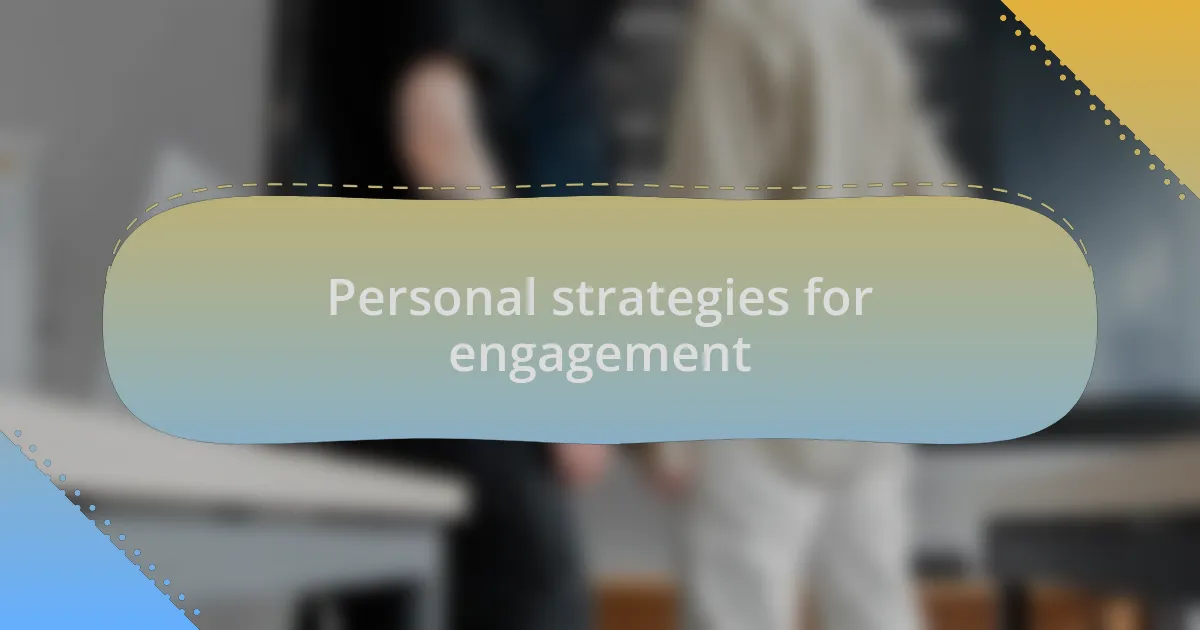
Personal strategies for engagement
One personal strategy I always apply is fostering a sense of community within the game. In a multiplayer project I worked on, I created in-game events where players could collaborate to achieve objectives. Witnessing players form friendships and strategize together added a layer of engagement I hadn’t anticipated. Have you ever felt more invested in a game just because of the friends you make along the way?
Another approach I find effective is utilizing narrative choices that resonate emotionally with players. During the development of a story-driven game, I allowed players to make decisions that deeply impacted the storyline and character relationships. I was amazed at how players would share their own experiences and feelings based on the choices they made. Doesn’t it enhance the gameplay when players feel they’ve left a personal mark on the narrative?
Lastly, I focus on creating a visually cohesive environment that tells its own story. In one of my indie games, I crafted backgrounds that hinted at past events within the game world, encouraging players to piece together the lore. I noticed that players would spend extra time exploring these details, which fostered a deeper connection to the game. Isn’t it remarkable how much lore can be conveyed through subtle visual cues?

Case studies of successful environments
In examining successful game environments, I often reflect on the mobile game “Alto’s Adventure.” This game masterfully combines stunning visuals with fluid mechanics, creating an experience that feels both tranquil and exhilarating. I remember the first time I played it, feeling completely immersed as I slalomed down the mountains. Doesn’t the art and atmosphere in a game often shape your emotional response?
Another compelling case is “Stardew Valley.” The game’s emphasis on community interaction and player-driven goals truly exemplifies how engagement can flourish through simple yet effective design choices. I recall spending countless hours in that pixelated town, befriending villagers and tending to my virtual farm. It made me ponder how a sense of belonging and achievement can pull players back repeatedly.
Finally, “The Legend of Zelda: Breath of the Wild” showcases an open environment that encourages exploration. I remember my curiosity leading me to discover hidden shrines and quests that significantly enriched my gameplay. Doesn’t it feel rewarding when a game respects your freedom and invites you to uncover its secrets at your own pace?